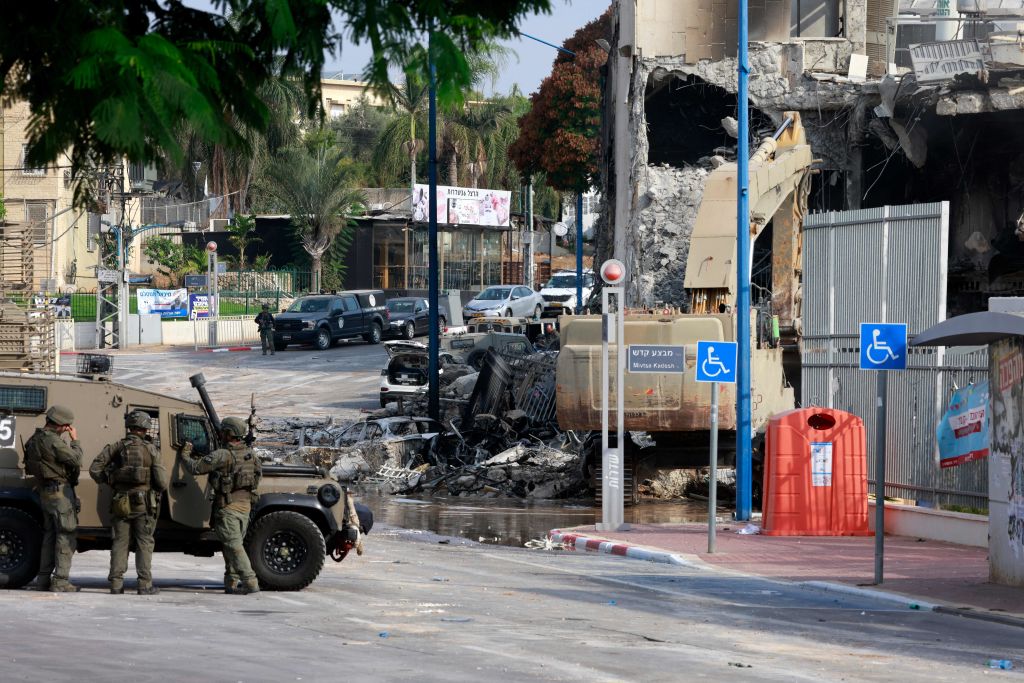Israelis awoke to sirens on Saturday. They began after six in the morning on the border of Gaza as Hamas began to fire thousands of rockets at Israeli towns and cities. By eight o’clock the rocket fire had reached Jerusalem. By the evening the full extent of the massive attack had become clear. Over 5,000 missiles were fired as Hamas launched an unprecedented attack across the border, infiltrating a dozen communities and massacring civilians.
I drove down to the border of Gaza after hearing the sirens in the morning in Jerusalem. Israel’s Iron Dome air defence system was active, intercepting rockets over my head. This is routine in Israel’s wars: the sound of sirens and the percussion of interceptions. But Saturday’s experience was even more unsettling as reports suggested that not all those terrorists who had infiltrated had been found. There were ongoing gun battles in some communities. The sense of danger was palpable.
Eventually I made it to the border, where ambulances sat in long lines waiting to take out any wounded found in liberated communities. The army was on the move as well, with soldiers being called to reserves all over the countries. Some of the soldiers left their cars in long lines outside their muster stations. By the afternoon they were on vehicles heading toward Gaza.
Harrowing images have flooded social media, showing Hamas terrorists wandering around Israeli communities, automatic rifles in hand. The militant group has kidnapped numerous people, carting their hostages off to Gaza. They have paraded dead bodies in the streets. These images will be ingrained in peoples’ minds for years to come along with the other difficult memories Israelis have of past massacres, such as the terror attack on the 1972 Olympics or the attacks that began the 2006 war between Israel and Hezbollah.
How could a country that prides itself on high levels of intelligence gathering and the latest generation of defence technology be lulled into such a devastating ambush?
The 7 October attacks are different than those in the past. Israel has faced many enemies historically and even faced surprise attacks in the past. It is the 50th anniversary of the Yom Kippur war, when Egypt and Syria surprised Israel with a massive assault using legions of tanks. However, over the last few decades Israel has become used to fighting terror groups, in what is usually called a counter-insurgency type of warfare. This means that Israel uses its superior technology and advanced warplanes, like the F-35, to carry out precision strikes on terrorists who usually hide in civilian areas. In general these kinds of conflicts have actually reduced the overall level of violence between Israel and groups like Hamas or the Palestinian Islamic Jihad.
That was true until the attacks. Now hundreds of Israelis are reported killed and thousands injured. The full death toll may not be known for days. The fate of those captured or the bodies taken to Gaza may never be known. The fact that Hamas was able to attack 20 communities in southern Israel calls into question where Israel’s security forces were during the attack. How could a country that prides itself on high levels of intelligence gathering and the latest generation of defence technology be lulled into such a devastating ambush?
By nightfall on Saturday, it was clear how much Israel had changed. Many restaurants that otherwise might open after Shabbat, which takes place on Saturday, were closed. Streets felt deserted. The sound of warplanes overhead and explosions in Gaza meant that the war had begun in earnest. Now Israel faces the complex question of how it will carry out operations after this attack. Hamas has enjoyed a kind of legitimacy in some areas of the Middle East. It is backed by Iran and its leaders fly around the region, enjoying time in places like Lebanon. Iran has increased its threats against Israel recently. The Hamas attack is an example of how deadly the Iran threat has become.






Comments